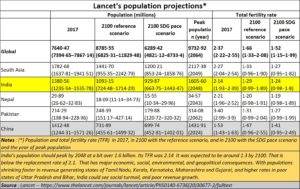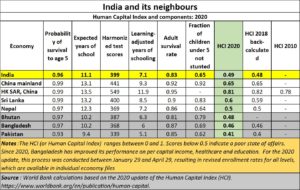https://www.firstpost.com/business/demographics-and-agriculture-ticking-time-bombs-will-union-budget-2022-address-them-10309221.html
If Budget-22 does not address demographics and agriculture, it will be a tragic error
RN Bhaskar
The budget papers should get placed before the Parliament in a matter of a few days from now. And it is quite possible that the government will focus on subsidies and on creating incentives for industrial growth. But this author’s fervent prayer is that the government pay great heed to demographics and to the farm sector. In some ways, both are inextricably interlinked. India’s economic growth depends on these.
 First, the demographics. India has almost lost the demographic dividend it boasted to the world with a swagger. It is quite possible that India has missed the bus. It has failed to invest in its people. Its population growth rates have been sinking alarmingly.
First, the demographics. India has almost lost the demographic dividend it boasted to the world with a swagger. It is quite possible that India has missed the bus. It has failed to invest in its people. Its population growth rates have been sinking alarmingly.
In fact, its population growth rate could dip below that of China (https://www.thelancet.com/journals/lancet/article/PIIS0140-6736(20)30677-2/fulltext), unless India puts the right measures in place.
But isn’t a falling population good news for India? No. It means that more old people will have to be taken care of by a shrinking youth population. That will put greater pressure on already weakened healthcare services, and household costs.
Second, as Ruchir Sharma points out (https://www.ndtv.com/india-news/dr-prannoy-roy-ruchir-sharma-on-2022s-top-10-trends-full-transcript-2696979) no nation has been able to grow faster than 7% annually without a growing (young) population.
 What makes India’s case worse is that its revenue generating states in the south and the west (which account for over 50% of India’s GDP and taxes) are witnessing lower birth rates, while the poverty stricken and populous Hindi belt (which does not generate enough wealth) is witnessing a birth rate higher than the replacement rate of 2.1. When wealth generators begin to diminish, and those of subsidy takers increase, India will have a big problem,
What makes India’s case worse is that its revenue generating states in the south and the west (which account for over 50% of India’s GDP and taxes) are witnessing lower birth rates, while the poverty stricken and populous Hindi belt (which does not generate enough wealth) is witnessing a birth rate higher than the replacement rate of 2.1. When wealth generators begin to diminish, and those of subsidy takers increase, India will have a big problem,
Add to this the inability of the government to make people of all sects and creeds to work as one nation. The divisiveness will further cripple India’s ability to be productive. This will crimp the government’s ability to give out doles all the time. It may do so selectively, which could lead to more strife and disruption.
Can the budget help?
So, what should the budget do? It should focus on education and healthcare first. That is the primary investment a population requires. Without education, the population cannot become more productive. This means that India’s school education must be overhauled.
True education is a state subject. But the centre has powers to give tax exemptions and grants. Link all tax exemptions and grants to measurement of outcomes of students, teachers and even schools (https://asiaconverge.com/2020/08/the-national-education-policy-has-little-vision-less-strategy/). Those with good outcomes could expect better grants. Those with poor outcomes risk losing their schools and all the grants. Poorly managed schools could be handed over to good education managements. That can actually make learning and competing with the world more effective.
 Ditto with healthcare (https://asiaconverge.com/2021/11/no-atma-nirbharta-without-healthcare/). India’s record on both education is terrible – see its score on the Human Capital Index (https://asiaconverge.com/2021/08/india-loses-focus-on-human-capital/).
Ditto with healthcare (https://asiaconverge.com/2021/11/no-atma-nirbharta-without-healthcare/). India’s record on both education is terrible – see its score on the Human Capital Index (https://asiaconverge.com/2021/08/india-loses-focus-on-human-capital/).
India’s population could have become immensely productive if investments were made on human development.
Agriculture
Over 50% of India’s population is engaged in agriculture, and hence this should be the next most important item on the government’s agenda. To understand how serious the problem is, one needs to first recognise that the farmer is today extremely distressed, which also partly explains why this community has witnessed the highest suicide rates.
Today, the small farmer earns little through cultivation, and must augment his income through daily wages elsewhere or through animal husbandry. The rich farmer earns much more, partly because of government policies that favour big farmers (https://asiaconverge.com/2021/12/msp-is-a-bad-idea-say-many-economists-really/) and also because the government has not focused on making small farmers climb the value chain – through policies that allow extension players to handhold the farmer. This is what Narendra Modi did in Gujarat when he was chief minister (https://asiaconverge.com/2010/05/narendra-modis-farm-miracle/). He allowed players like drip irrigation companies, to collect their subsidy amount only if they actually handheld the farmers and taught them best agricultural practices. He also insisted that they ask students of nearby agricultural universities to accompany their field staff, so that the students could learn modern practices which classrooms were not equipped to teach.
The budget should incentivise such handholding, and focus on farmer literacy programmes. Avoid subsidies because they make farmers dependent on government doles. Subsidies weaken the strong, and reward the weak (https://asiaconverge.com/2022/01/dear-india-it-is-later-than-you-think/). Instead, have an MSP for all agri commodities, including milk, especially in Uttar Pradesh (https://asiaconverge.com/2021/12/msp-is-a-bad-idea-say-many-economists-really/).
Farm reforms
Make farmers, commodity markets and warehousing stronger by doing five things.
First, make the Food Corporation of India (FCI) procure the grain its needs from com oddity markets and not directly from farmers (https://asiaconverge.com/2021/09/need-sensible-laws-to-stop-farmer-exploitation/). This will prevent small farmers being marginalised.
Second, create incentives for warehouses under the WDRA (Warehousing Development Regulations Act) which was meant to create warehouses for every type of agri produce within 50 km of any farmer in the country (https://asiaconverge.com/2017/08/is-wdra-a-functioning-organisation/). If the farmer can sell his produce quickly, his distress levels will decline.
Third, link warehouses with the best managed FPOs for every commodity so that the produce can be processed and value-added for domestic and export markets. Follow the NDDB model, so brilliantly conceived of by Verghese Kurien, the Milkman of India (https://asiaconverge.com/2020/02/verghese-kuriens-milk-model-curdled/). And stop discriminating against the dairy industry when it comes to taxation (https://asiaconverge.com/2021/02/budget-2021-has-little-for-animal-husbandry-and-marginal-farmers/). Also, please compensate the farmer for each old cattle that he is not allowed to sell (https://asiaconverge.com/2021/05/agenda-1-dont-meddle-with-the-dairy-sector/).
Fourth, allow small farmers to lease their lands to bigger farmers, or to corporates, so that they can get their income without having to lose ownership of their lands that they are sentimentally attached to. This will also pave way for consolidation of farming, without making the small farmer lose. His rental can include a share of farm produce plus rental without losing ownership of land.
Lastly, gently nudge horticulture farmers towards hydroponics (https://asiaconverge.com/2018/06/hydroponics-could-be-the-future-of-farming/).This way they can protect themselves against climate change, yet increase productivity.
If these are done, farmers will have higher incomes, less distress. The added purchasing power will translate into enhanced demand for industry and the economy. That is the safest way to ensure GDP growth, yet prepare a population for more challenging times ahead.










































COMMENTS